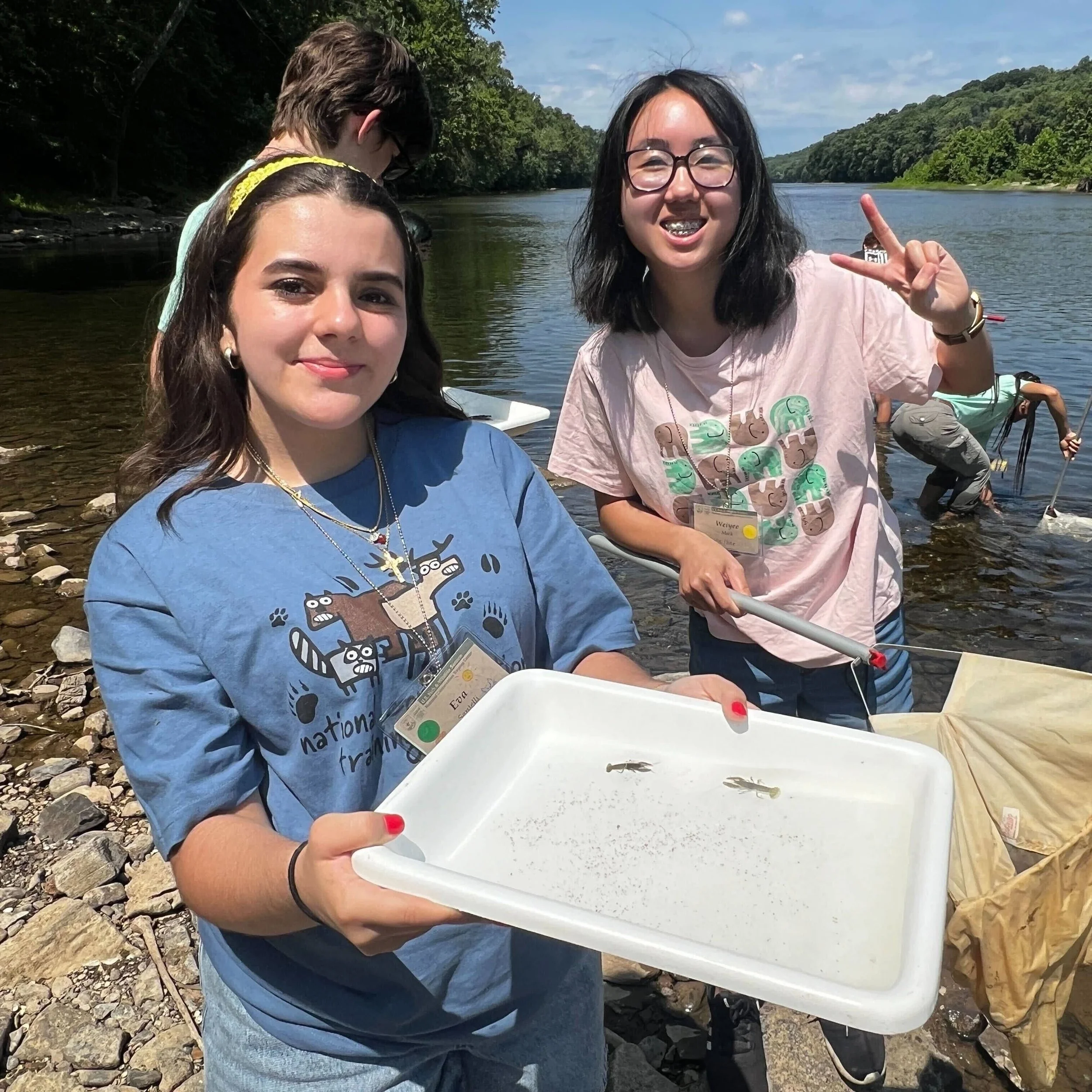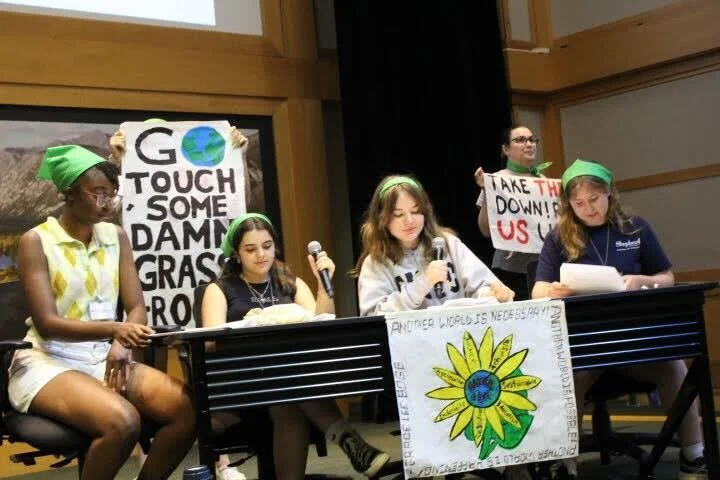My Sc3 Experience, 2024
Eva Santelli (16) from New York State shares her transformative experience at Sc3: the Student Climate and Conservation Congress, hosted by the Green Schools Alliance in collaboration with the U.S. Fish and Wildlife' Service’s National Conservation Training Center (NCTC) in Shepherdstown, West Virginia.
Have you ever experienced something so transformative that it completely reshaped your perspective on something you are passionate about?
For me, the Student Climate and Conservation Congress (Sc3) was that experience. It was not just a week away from home; it was a whirlwind of transformation and growth that introduced me to a community of like-minded individuals of all ages and backgrounds who touched and inspired me to make tangible change in the world. Here is how Sc3 turned my environmental passions into motivation to collaborate with others to join a movement for global and local change.
Navigating New Paths in Environmental Activism
At school, you can often find me making announcements at lunch time reminding students to recycle, filling in the students and staff on environmental initiatives around campus during assemblies, or updating my precious recycling sign in the cafeteria. I will always take great pride in these small but impactful acts of stewardship within my community, feeling a great connection to each one. However, as a young environmentalist from a small town, it can often feel like you are swimming against the current alone, watching as your stories and perspectives are drowned out by devastating news of climate catastrophes. At Sc3, I was introduced to a new world of motivated and encouraging people who shared the same desire to learn and listen to each other with the common goal of sparking change in the world. I felt truly heard and respected as an environmentalist, something I believe all like-minded individuals should be able to experience, as it gave me the confidence to change the world for the better.
Students from all around America came together to form a unique and incredible community at Sc3.
Before I even applied to Sc3, I read testimonials from student fellows that advertised a life changing experience. I was skeptical–How could one week possibly change the rest of my life? But, driven by my stubborn hope and a dash of nervous anticipation, I submitted my application in which I wrote about my passion for conservation and environmental activism. After a few more hours of attempting to cram my collection of reusable water bottles into my suitcase (spoiler: it didn’t fit), I slipped on my flower-embroidered Converse and somehow stumbled my way from New York to West Virginia. I arrived at the National Conservation Training Center so nervous that I felt like a little duckling struggling to paddle upstream, only to be greeted by warm smiles, a board game involving birds, and icebreaker activities that made me feel like I had finally found my flock.
From Local Roots to Global Perspectives: the Interconnectedness of Sc3
This “flock” was composed of student fellows and faculty members from states across the country and even different continents, each sharing their unique perspectives and experiences within their respective fields. Whether they shared about their future aspirations, environmental issues within their communities, or current initiatives, their stories were all equally inspiring and motivating. Whenever someone spoke, I listened not just to form a response but to instead truly understand what they had to say. As I did this, I began to notice that all of our stories weaved together to form a larger web of interconnected thoughts and ideas, filling me with both hope and fear for the future while also reminding me of the intricate web of ecosystems each one of us were fighting to protect. No matter how different our backgrounds were, our differences were what allowed us to form such a unique and special community, creating memories together that could never be forgotten or recreated as we all related to our desire to shape a just, regenerative, and sustainable future.
Tributaries of Learning: a Trip to the Potomac
The morning before the river trip was full of electrifying energy as everyone buzzed with excitement while our favorite river-rat Mike Dudash prepared us for a day full of laughter, learning, and using our kayak paddles as splashing devices. “Don’t be afraid to get wet!” he shouted at us with a grin, spreading his awfully contagious enthusiasm to everyone present as we marched down to the river. Though I had never kayaked before, his pep talk was enough to make me believe I could master the art of paddling like a seasoned professional as I bravely set out in a tandem kayak. Eventually, I got the hang of it and was able to peacefully paddle as I took in the nature surrounding me: the rhythmic lapping of water against the kayak, the sunlight beaming on my legs, and the scent of damp earth occasionally mixed with the slightly embarrassing detour of getting stuck on a rock, which I totally meant to do, and the cooling effect of a quick splash-match as I battled my fellow river-rats in their kayaks.
Kayaking down the Potomac River reminded us of our interconnectedness with each other and our planet.
My favorite part of this river trip was when Mike called everyone in for a moment of silence. As we all floated next to each other in our kayaks, listening to the sounds of the earth, I was hit with a wave of gratitude that brought to light everything that I was working so hard to protect. This peaceful moment on the river turned into a reminder that every effort of conservation is just one piece of a larger puzzle that’s full of chirping birds, buzzing insects, and rustling leaves.
My next trip to the river was for a macroinvertebrate surveying workshop headed by Sharon Dorsey. Picture this: a group of teens huddled over water samples, placing tiny creatures under microscopes, striving to identify them. I truly have been surrounded by a group of kids so excited over finding a mayfly. Many crayfish and stoneflies later, it became clear to me that each of these tiny critters was a crucial part of a complex ecosystem, just like how individual efforts in the climate movement can join together to form an interconnected wave of change essential for the well-being of our planet.
Studying time creatures in the macroinvertebrate surveying workshop helped us understand the interconnectedness of our fragile and complex ecosystems.
Voices of Wisdom: Sc3 Mentors and Speakers
Just as how each tiny critter contributes to the health of the river, the knowledge and insight we gained from our many mentors and speakers at Sc3 was crucial in advancing our collective conservation efforts. The mentors and staff at Sc3 were a group of qualified and inspirational individuals who truly recognized each person's potential and were committed to seeing us make the positive changes in the world they knew we were capable of. Their encouragement was to us a refreshing breeze of cool air to sweep away the humid Shepherdstown weather. Their passion for their work was palpable in their endless support for our environmental initiatives and their eagerness to answer questions and share their experiences about their life and work. This unwavering support both inspired us and left us feeling empowered to tackle any challenges ahead, knowing we had an incredible team always ready to cheer us on along the way.
Each evening at Sc3, we had the opportunity to listen to presentations from a carefully selected array of speakers who, despite all having different stories to share, left us feeling equally as inspired and motivated to make change in the world. One speaker, Jimmy Fox, motivated us to make radical change in the world by speaking passionately about the threats that the Arctic permafrost faces due to climate change. He did this through sharing a quote from Raymond Williams:
“To be truly radical is to make hope possible rather than despair convincing.”
He then challenged us to think about what our next actions would be in this daunting climate crisis and if they were genuinely radical in the sense that they inspired hope instead of reinforcing despair and anxiety. This allowed each of us to reflect on how our efforts could drive real, long-term change in the world. Another speaker, Brandon Dennison from Coalfield Development closed his presentation off with a rather confusing slide that simply read: “Geese > Crabs,” accompanied by images of the two animals. After we briefly puzzled over this strange comparison, Dennison explained to us that, unlike crabs, which pull each other down in confined spaces, we should strive to be more like geese, which work together in a coordinated formation that supports each individual member. This highlighted how important collaboration was at Sc3 and in the world at large. Just as geese uplift one another, making positive change in the world requires us to support and further the efforts of those around us, which is something I carried with me throughout Sc3 and still cherish today.
Starting a Revolution: Open Space Collaboration Groups
In OSC (Open Space Collaboration), we worked in teams to develop and present projects geared for solving climate and environmental problems.
At Sc3, participants have the opportunity to join an Open Space Collaboration (OSC) group, where we work together in student-driven teams on unique topics to develop and present a project called a deliverable. I was drawn to the Community and Local activism group because it is a cornerstone of my values, as I greatly aligned with the group's mission to amplify the voices of local activists in the fight to mitigate climate change. Our group’s deliverable was a dramatic, scripted debate between ExxonMobil representatives and a group of community activists that ended in the beginning of a revolution for not just some theatrical flair but also in order to show the contrast between corporate interests and grassroots advocacy, as the local activists showed the importance of standing up against corporate greed. This showed the impact that a united community can have against flawed corporate behavior that causes great environmental harm.
Working together on a deliverable involves great collaboration, as each member in a group brings unique skills to the table. We had talented artists who created signs, flags, and other props, dynamic actors who brought the script to life with their vibrant performances, and brilliant writers who created a compelling narrative. Despite our different roles and abilities, we were all united by a common goal: to demonstrate the power of community activism and the continued need to fight against environmental injustices.
The deliverables from other OSC groups were equally as inspiring. Some created websites to promote the importance of mental health in times swarmed with “climate anxiety,” others pitched innovative and sustainable business models in a Shark Tank-style video presentation, and one group even crafted a stop-motion video to educate us about microplastics. Each project reflected the diverse ways in which climate change impacts different aspects of society, highlighting the creativity, resilience, and cooperation we need to build a just, regenerative, and sustainable future.
Creativity, resilience and cooperation are what we need to build a just, regenerative, and sustainable future!
Inspiration to Action
Our final moments at Sc3 were mainly filled with us trying to hold back tears as we said goodbye, though our attempts felt more like trying to stop a tidal wave with a teacup—until a quick dance party broke out, turning our bittersweet farewell into a energetic mess of flailing arms and laughter. As I returned home from Sc3, I felt deeply inspired and began planning future initiatives, even becoming a student intern for the Green Schools Alliance. My experience at Sc3 made me realize how our personal perspectives and backgrounds in life shape our journey, influence the way we connect with one another, and allow us to unite over one common goal, causing me to consider the question:
“How can our personal stories shape the new narrative we need to create a just, regenerative, and sustainable future for all?”







